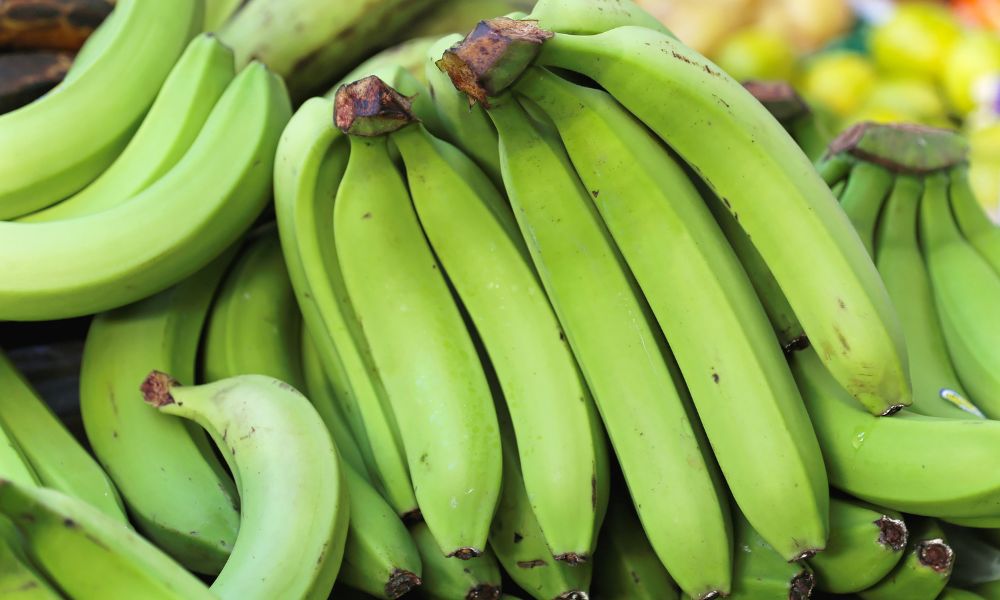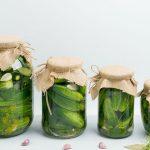Have you ever purchased a bunch of green bananas, only to realize later that they take forever to ripen? Confusing, isn’t it? Worry not, dear reader! This guide aims to enlighten you on the ripening process of those pesky green bananas, and how to make the most out of them.
And yes, we’ll even delve into the nitty-gritty of why they’re green in the first place, and how long the ripening process truly takes. Trust us, you’ll be a green banana pro in no time!
Understanding Green Bananas

So, what is the deal with green bananas? Let’s take a quick look at their characteristics. Green bananas are, in essence, just unripe bananas harvested before their prime. They’re plucked from the trees when they’re still green, firm, and full of starch. Interestingly, bananas are one of the few fruits that ripen best after they’re harvested, which for us consumers, means they have a longer shelf life. And who doesn’t love that?
Now, you might be curious as to why we even harvest bananas green in the first place. It’s mostly about logistics: transportation and storage are much easier with green, durable bananas than with yellow, mushy ones. Oh, did we mention that transportation time can also speed up the ripening process? That’s right! The hustle and bustle of being shipped from their tropical homes to your local grocery store can sometimes cause them to turn yellow before they even make it to your fruit basket.
But enough about logistics; how do green bananas differ from ripe ones in terms of taste, texture, and nutrition? Well, green bananas are undoubtedly firmer and hold less sweetness than their yellow counterparts. Some might even call them bland. But don’t be fooled, green bananas hold some benefits, like being richer in resistant starch, which can help with digestion. As they ripen, bananas convert starch into sugar, which means the riper the banana, the sweeter and softer it’ll be. So, it’s really a matter of personal preference when it comes to the taste and texture of your banana.
Factors Affecting Ripening Time

Now that we’ve got the basics down, let’s explore why and how green bananas ripen. Three main factors influence the ripening process: temperature, humidity, and ethylene gas. Yeah, we know it sounds like a science experiment, but hang in there, we’ll break it down for you!
🌡️Temperature
The phrase “chilling out” takes on a new meaning when it comes to ripening bananas. Increased temperature generally speeds up the ripening process, with the sweet spot being around 65-68°F (18-20°C). An interesting nugget of information is that bananas can ripen at lower temperatures, albeit sluggishly. However! Beware temperatures below 58°F (14°C), as they may cause cell damage, leading to some funky textures and tastes.
💧Humidity
Humidity plays an essential role in a banana’s ripening journey. Simply put, high humidity slows down moisture loss and prevents the bananas from drying out. A humidity level of around 90-95% is ideal to maintain the fruit’s quality, so it’s safe to assume that steamy tropical locales are perfect breeding grounds for ripe bananas.
😯Ethylene Gas
Here’s where things get really interesting. Ethylene gas is a natural plant hormone that regulates growth, and guess what? Bananas produce it during the ripening process! In fact, the more ethylene a banana produces, the quicker it’ll ripen. This knowledge is pure gold, as it allows us to appreciate (and manipulate) the process. Feeling impatient? Well, you can speed up the ripening of your green bananas by placing them near other ethylene-producing fruits, like apples or avocados. Got that? Good! Let’s move on.
[su_box title=”Most People Don’t know” style=”default” box_color=”#DC1182″ title_color=”#FFFFFF” radius=”3″]Avoid Refrigeration: Refrigeration actually delays the ripening process, but it can help already ripened bananas stay at their peak for longer. Green bananas should not be kept in the fridge.[/su_box]
How Long Does It Take for Green Bananas to Ripen?
If patience isn’t your strongest suit, you’re probably dying to know just how long it takes for green bananas to ripen. Here’s the thing: it can vary. There isn’t a one-size-fits-all answer, as factors such as temperature, humidity, and banana variety all play a role.
However, to give you a general idea, we’d say it usually takes around 2 to 7 days for green bananas to ripen at room temperature. It may not be an exact science, but hey, life’s all about unpredictability, right?
Tips for Ripening Green Bananas

Now that we’ve got all the theoretical aspects covered, let’s jump into some hands-on strategies to ripen your green bananas quicker and more efficiently. Don your lab coats and gloves, folks; we’re about to delve into the world of banana optimization!
Store Bananas in a Warm, Well-Ventilated Area
As we mentioned earlier, temperature is crucial in the ripening process, so make sure you store your bananas in a cozy spot that isn’t exposed to direct sunlight. Ensure the area has adequate airflow to prevent mold from souring your efforts.
Place Green Bananas in a Paper Bag with an Ethylene-Producing Fruit
The beauty of ethylene gas lies in its ability to speed up the ripening process when in close proximity to unripe fruit. Simply place your green bananas in a paper bag (never plastic), add an apple or an avocado, and let the magic unfold! The bag traps the ethylene, thus creating a tropical paradise for your bananas.
Steer Clear of the Refrigerator
Do not—I repeat, do not—store green bananas in the refrigerator! Chilling out may be great for us, but it’s terrible for bananas. The cold temperatures slow down the ripening process and can even damage the fruit’s cells, resulting in an odd taste and texture. So save the fridge for your leftovers and let the bananas breathe!
Bananas are great. As the first sign of ripening, they are full of starch and as they ripen, the starch turns to sugar. So the riper the banana, the sweeter it will be.
– Martha Stewart
The Nutritional Value of Bananas Throughout the Ripening Process
As bananas ripen, their nutritional composition undergoes several changes. Here’s the lowdown on how the different stages of ripeness affect their nutritional content:
- Green bananas are higher in resistant starch and lower in sugar compared to their ripe counterparts. The resistant starch in green bananas acts as a prebiotic, promoting healthy gut bacteria growth.
- As bananas ripen, the levels of vital micronutrients such as antioxidants, vitamin C, and vitamin B6 significantly increase. This transition is why ripe bananas are often touted for their many health benefits.
- The glycemic index (GI) of bananas tends to increase as they ripen. Although this may be concerning for individuals with diabetes or those who strictly adhere to a low GI diet, the overall GI increase throughout ripening is still relatively moderate.
In summary, bananas offer a variety of health benefits at various stages of ripeness. It’s essential to find a balance that suits your taste and nutritional preferences.
FAQs
Can I eat green bananas?
Absolutely! Green bananas can be consumed, although their taste and texture differ significantly from ripe bananas. Due to their high starch content, they can be quite firm and not as sweet as when they’re ripe. Green bananas can be incorporated into various recipes, such as curries and as a substitute for potatoes, or enjoyed as fried banana chips.
How can I tell if a green banana is ripe?
To determine if a green banana is ripe, look for changes in color, texture, and aroma. Ripe bananas are typically yellow with some brown spots on the skin, have a softer texture, and emit a sweet, fruity scent. The more brown spots on the skin, the riper and sweeter the banana will be.
Are green bananas as nutritious as ripe bananas?
Green bananas and ripe bananas have their own sets of nutritional benefits. Green bananas contain more resistant starch, which promotes healthy gut bacteria and improves digestion. On the other hand, ripe bananas have higher levels of antioxidants, vitamins, and natural sugars. In essence, both green and ripe bananas provide valuable nutrients, so including both in your diet can be beneficial.
Can I store green bananas in the refrigerator?
It is not recommended to store green bananas in the refrigerator, as the cold temperatures can slow down the ripening process and even damage the fruit’s cells, leading to an odd taste and texture. Instead, store green bananas at room temperature in a well-ventilated area to allow for proper ripening. However, if you have ripe bananas that you want to preserve for a longer time, storing them in the refrigerator can help slow down further ripening and extend their shelf life. Just be mindful that the banana skin may turn brown in the fridge, but the fruit inside will still be good to eat.
Conclusion
Let’s pause and take a moment to recap the journey you’ve embarked upon with us. You entered the realms of green bananas, learned about their ripening process, and have even mastered the art of speeding up their transition to that golden, delicious state. By now, you’ve become a bona fide banana aficionado, capable of understanding the intricacies of these fascinating fruits.
As for optimal flavor and nutrition, it’s crucial to allow green bananas to ripen properly. The ripening process isn’t just for show, after all; it influences taste, texture, and even nutritional value. Feel free to experiment with different stages of ripeness, or get creative with some delightfully delicious recipes using ripe bananas.
Lastly, let’s not forget how green bananas can make a journey of their own through fruit airport security LINK. After all, who wouldn’t love to have these versatile fruits by their side while conquering the world, right?
References:








